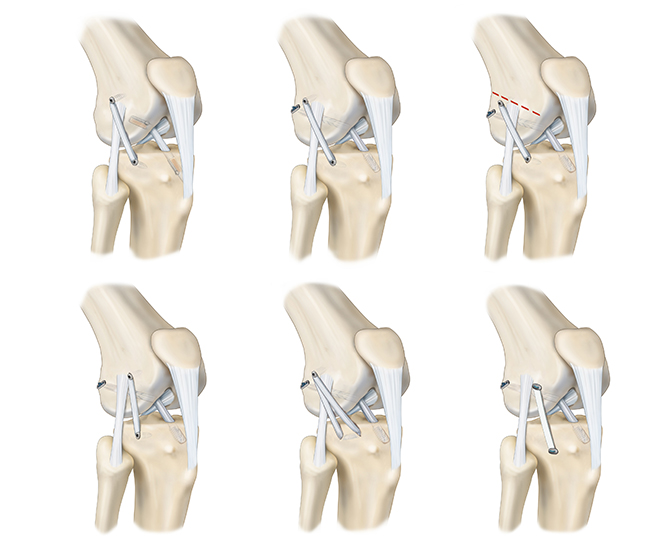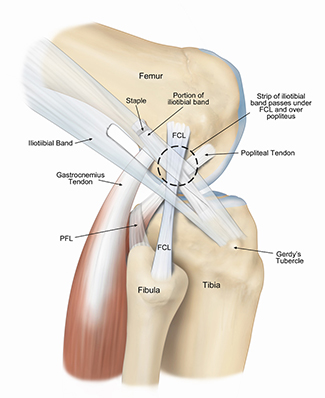Lateral Extra-Articular Tenodesis (LET)
Anterolateral Ligament (ALL) reconstruction and lateral extra-articular tenodesis (LET) are advanced surgical techniques used to stabilize the knee joint, particularly for individuals suffering from ACL injuries. ACL injuries often create knee instability which can lead to additional damage in other structures of the knee. The ALL plays a significant role in knee stability and, as such, its repair and reconstruction have become areas of focus in orthopedic medicine to decrease re tear rates.
There are specific indications that may determine the need for ALL reconstruction or LET. These include patients with high-grade pivot-shift (significant rotational instability), cases where previous ACL reconstruction has failed, and instances with an increased risk of future ACL injury due to certain characteristics such as young age, high activity level, or those involved in pivoting sports. The decision to perform these surgeries depends heavily on an individual’s specific circumstances and requirements.
In recent years, research surrounding ALL reconstruction and LET has surged, providing valuable insights into their effectiveness. A 2019 study published in the American Journal of Sports Medicine found that adding ALL reconstruction or LET to an ACL reconstruction reduced the chance of graft failure and improved rotational stability. Moreover, these procedures helped preserve the health of the cartilage and meniscus by reducing the excessive load and stress placed on these structures after an ACL injury. Dr Chahla has published extensive research on the biomechanics of these structures and the best techniques to address rotational instability in the setting of an ACL tear.
The techniques used in ALL reconstruction and LET vary. ALL reconstruction typically involves making small incisions around the knee, through which the surgeon will insert grafts to replace the damaged ligament. On the other hand, the LET procedure involves tightening the lateral structures (iliotibial band) of the knee to prevent excess rotation and shift. It is important to mention that various methods can be employed depending on the surgeon’s preference and the patient’s anatomy.
Below are different described techniques to reconstruct the anterolateral ligament.

A lateral extraarticular tenodesis is represented below.

Prognosis after the surgical intervention varies with each individual. Generally speaking, the prognosis is favorable with a significant reduction in knee instability and improved long-term knee health. Of note, the addition of a lateral reconstruction does not lengthen the time of recovery after an ACL reconstruction.
In conclusion, an ALL reconstruction and LET are viable surgical interventions for knees with high-grade instability resulting from ACL injuries. These procedures, while complex, offer an opportunity for patients to regain stability and return to their previous activities with an improved quality of life.
As with any medical intervention, it’s crucial to consult with a medical professional. The field is always advancing, with ongoing research focused on finding and improving the most effective treatments for ACL injuries. ALL reconstruction and LET represent significant strides in this arena, promising improved knee stability and health for those affected by ACL injuries.
Lateral extra-articular tenodesis (LET) is a procedure performed alongside ACL reconstruction to enhance knee stability, particularly in patients at risk for persistent rotational instability after an ACL injury. This procedure reinforces the lateral structures of the knee, reducing excessive rotational forces and lowering the risk of re-injury. LET is often recommended for high-risk athletes, individuals with hyperlaxity, or those undergoing revision ACL surgery. Dr. Jorge Chahla, a renowned orthopedic knee surgeon, specializes in advanced knee stabilization procedures, including LET, to improve long-term knee function and prevent future ligament injuries. If you are considering ACL reconstruction and want to explore whether LET is right for you, schedule an appointment with Dr. Chahla in Chicago, Naperville, or Oak Brook for a personalized evaluation.
At a Glance
Dr. Jorge Chahla
- Triple fellowship-trained sports medicine surgeon
- Performs over 700 surgeries per year
- Associate professor of orthopedic surgery at Rush University
- Learn more
